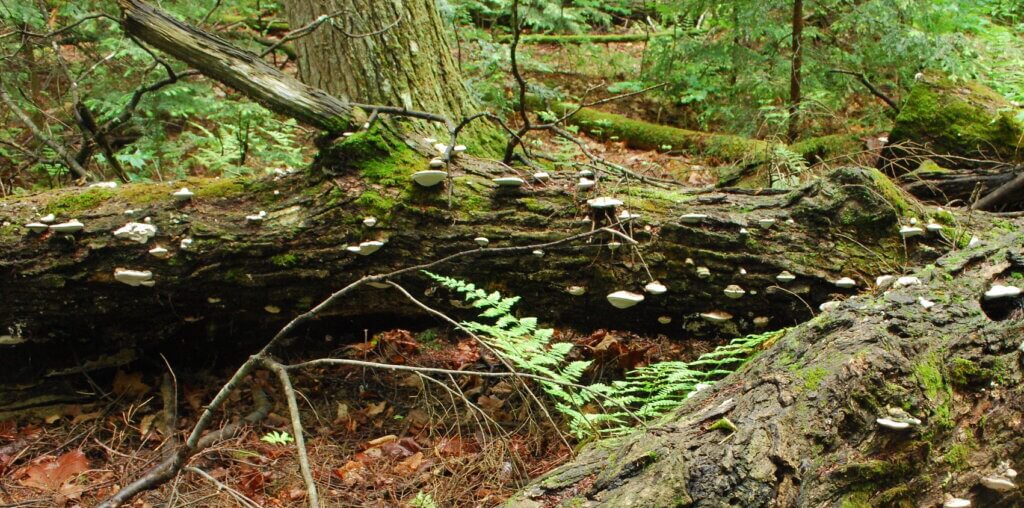If A Tree Falls…
By Anka Rashed
Broadcast 8.16 & 8.19.2023

Dead trees like this one are a source of diverse life in an ecosystem. Photo by Joshua Mayer, CC BY-SA 2.0.
Listen:
It’s a despondent afternoon in the early fall of 2019. A good friend has whisked me away to the nearby ghost town of Garnet, Montana, as a distraction from a recent heartbreak. We’re wandering around the mostly evergreen woods that surround the town, chattering about everything and nothing in particular, when we reach a sunlit clearing: a bright green grassy patch with just a handful of trees. There are a few leaves scattered around the ground, some being tossed around idly by a light breeze, but the atmosphere is otherwise soundless and still. Suspended.
And suddenly a sound, just up ahead. An odd rustling, except that we typically associate rustling with quietness and stealth, and this is not a stealthy endeavor. An old tree is finally succumbing to gravity’s persistence and rustling its way to the ground with an unquiet whisper, in a subdued display of its might. Almost like the ghost of a loud noise.
I’ve always been drawn to fallen logs. There’s a serenity within and around them that is too often ignored in favor of more glamorous aspects of the world we live in. After years of fascination with them, it occurs to me that a log is a lovely reminder of what death is, and what it isn’t. A dead tree is an entire ecosystem all on its own, crawling with life. It is a home and shelter, and consequently a hunting ground for any creatures who prey on those using the tree as shelter. It’s often largely barren, but can be punctuated with bursts of life and color in the form of so many organisms: insects, fungi, moss, lichens, slime molds, and so much more. And, perhaps the most grounding: as the aforementioned organisms break it down, it returns its nutrients to them and to the soil, returning its life into the ecosystem it borrowed from. Its death is not an ending.
And yet. As much as my adult self loves getting lost in the many questions and answers about life, death, and metaphysics that can come from dead trees, the simple love I have for them existed long before such concepts made sense to me. While I may have aged, the childlike joys of the pleasant springiness of the rotting bark and its wonderfully musty smell—a decomposing organism, something we as humans are wired to abhor, somehow smelling lovely and fresh–are as bright and rich as they’ve always been. But more than anything, I’m just swept up in the one-of-a-kind art piece that each fallen tree is. I’m lost in the endless swirls and whorls and oddities in the bark; the crooked, sunburst patterns of the roots, unearthed; the lacelike fractals of a mostly-decayed leaf; the distinctive channels created by certain species of beetle larvae, boring their way through the underbark to face the light of day for the first time. And how every line, crack, wrinkle, and knob tells its own story individually, but collectively, they all tell the same one.
So, here I am, in this forest near Garnet, watching an ancient giant make its elegant descent to the forest floor with a gentle—but powerful—whoosh. The impact disturbs the stillness, stirring up some leaves and dust; it’s as if the tree is waking the ghosts and announcing its arrival. After spending my life admiring the resounding impact a tree has on the world around it in life and in death, I’m now seeing the powerful one it also has in dying.
So I return to the age-old question. If a tree falls in a forest and there’s no one around to hear it, does it still make a sound?
It does. But only the ghost of one.
Every week since 1991, Field Notes has inquired about Montana’s natural history. Field Notes are written by naturalists, students, and listeners about the puzzle-tree bark, eagle talons, woolly aphids, and giant puffballs of Western, Central and Southwestern Montana and aired weekly on Montana Public Radio.
Click here to read and listen to more Field Notes. Field Notes is available as a podcast! Subscribe on Apple Podcasts or wherever you listen to podcasts.
Interested in writing a Field Note? Contact Allison De Jong, Field Notes editor, at adejong [at] montananaturalist [dot] org or 406.327.0405.
Want to learn more about our programs as well as fun natural history facts and seasonal phenology? Sign up for our e-newsletter! You can also become a member and get discounts on our programs as well as free reciprocal admission to 300+ science centers in North America!












